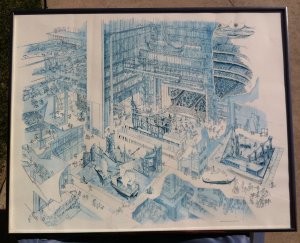Simanaitis Says
On cars, old, new and future; science & technology; vintage airplanes, computer flight simulation of them; Sherlockiana; our English language; travel; and other stuff
THE URBANE ART OF DONALD MACKAY
THOUGH I’VE never been there, I know my way around New York City’s home of the Metropolitan Opera. What’s more, I have a good idea of what its Lincoln Center Plaza site looked like 3000 years ago when the Lenape Native Americans resided there. For this knowledge, I thank artist Donald Mackay and his urbane art.

The Building of Manhattan (Dover Architecture), written and illustrated by Donald A. Mackay, Dover, 1987.
Born in Halifax, Nova Scotia, artist and illustrator Donald Mackay, 1914 – 2005, was also able to trace kin in Manhattan back to the 1640s. His love of its buildings, its urban environment and its history focused Mackay’s art. One product of this is his book, The Building of Manhattan; another is a poster celebrating the Metropolitan Opera’s inauguration of its new home at Lincoln Center in 1966. Other projects included a series on space flight and illustrations of the White House.
Native Americans of the Lenape nation lived along the Atlantic Coast and on Manhattan Island at least 3000 years ago. This was a matriarchal society which, notes Mackay, “adapted from a nomadic hunting people to an agricultural society. They believed in the magic power of all objects in nature, good and evil spirits, an afterlife, and a supreme being, the ‘Great Spirit.’ ” The word “Manhattan” is said to come from their language, “island of many hills.”

The Flatiron Building is at the intersection of Broadway and Fifth Avenue at 23rd Street, the plot of land dictating its iconic shape.
The first third of The Building of Manhattan is historical, the evolution from wood, stone and brick to iron followed by walls of steel and glass. Along the way, famous structures such as the Flatiron Building, 1901, and Empire State Building, 1930-1931, are described.
The rest of the book is an entertaining illustrated guide to the modern-day urban environment. Below ground is a world of water, electricity, steam, subway transportation and other vital services. At the other extreme, defying acrophobia is only part of an ironworker’s job requirement.

Guide for Backstage at the Met (Metropolitan Opera) NYC, poster by Donald A. Mackay for The New York Times, 1966.
Mackay’s Metropolitan Opera poster also offers a bird’s eye view, this one of opera production. There’s everything from the performance, orchestra and audience, to scenery changes being prepared for entr’acte to rehearsals taking place at various places throughout the building, set construction on upper floors and storage areas at subbasement levels.

The Met’s stage and wings permit a multiplicity of activities occurring at any one time. This and other images from portions of Mackay’s poster.
By the way, daughter Suz and I have been enjoying The Metropolitan Opera—Live in HD series at our local theater. During intermissions, these HD presentations show the high-pressure action of scenery setup accomplished by members of the International Alliance of Theatrical Stage Employees. I’m not surprised the Met’s is IATSE Local No. 1.
In vast workspaces three and four floors above stage level, scenery “flats” are laid out, fabricated and painted. These flats are always taller than life, at least in part to provide perspective for theatergoers in the Met’s upper Balcony and Family Circle.
During Met HD intermissions, we also get glimpses of productions in rehearsal. It’s fun to see opera stars early in the process not in elaborate costumes but in jeans and T-shirts.
The Met’s basements go down several levels. I wonder. Do you suppose that, like the Paris Opera House, there’s a lake… and a Phantom…?
Enjoying the details of Mackay’s work, I am amused to see two kids watching a Met Transfer truck at a loading dock. I like to image that they (and I) will be enjoying the Met from inside the building one day. ds
© Dennis Simanaitis, SimanaitisSays.com, 2015





